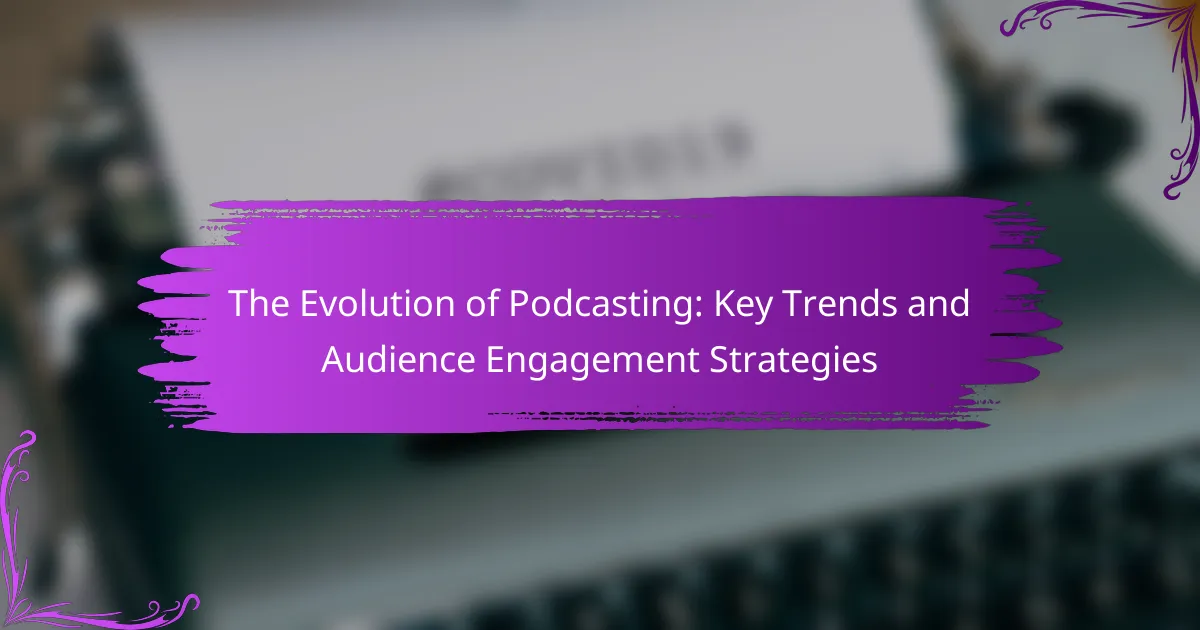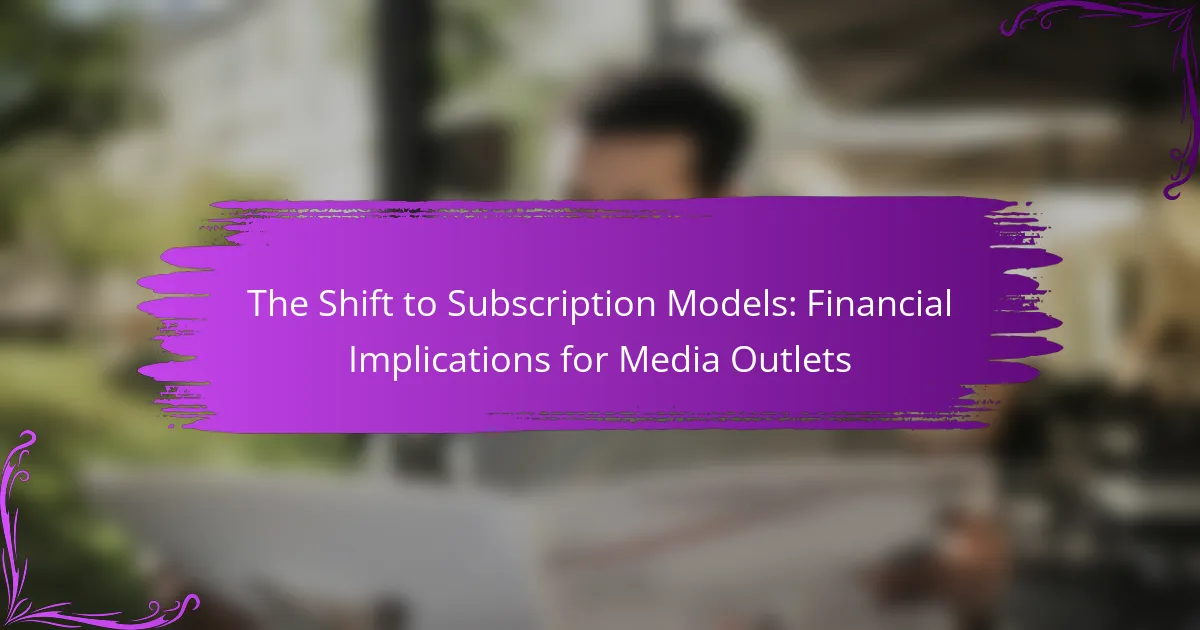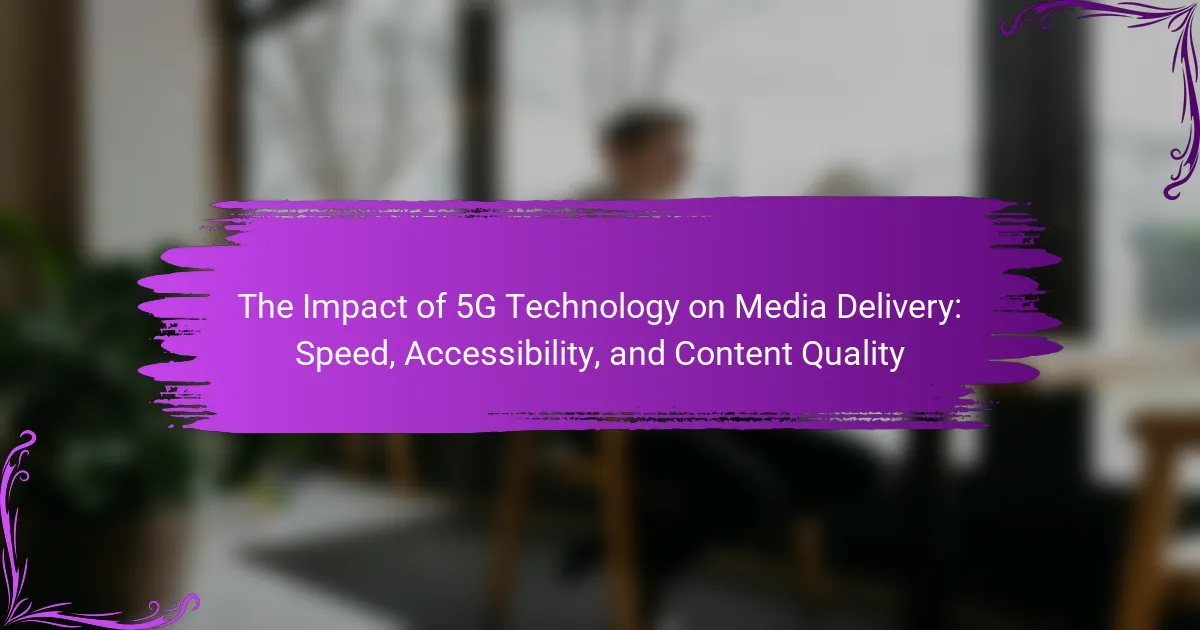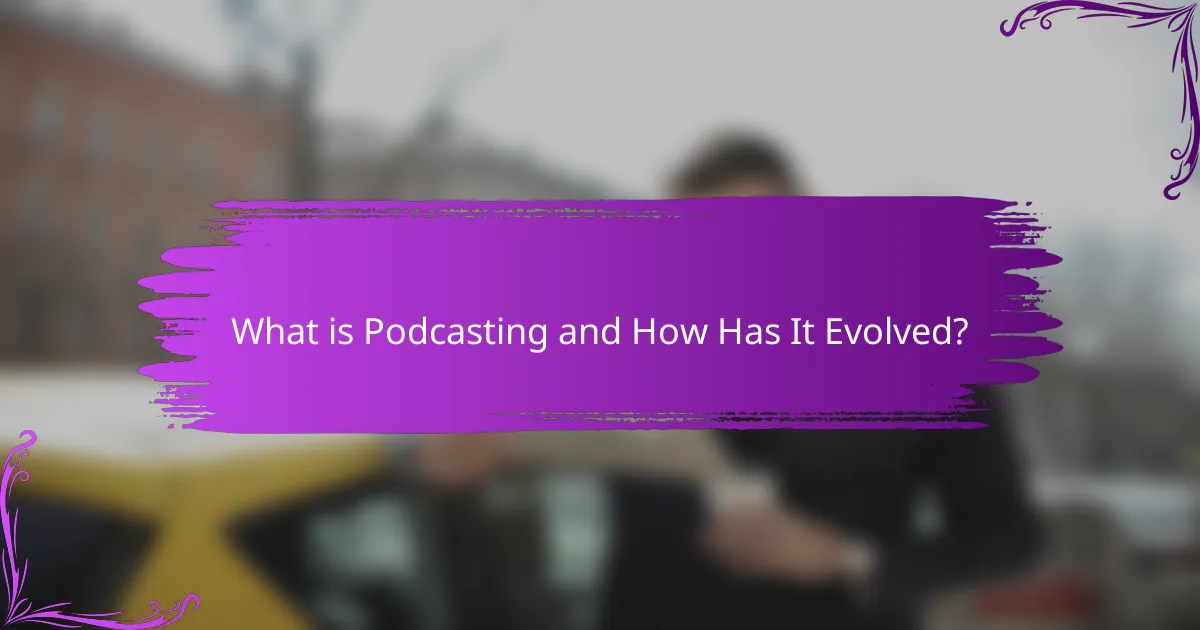
What is Podcasting and How Has It Evolved?
Podcasting is a digital audio medium that allows users to create, share, and listen to episodic content. It began in the early 2000s, initially gaining traction through RSS feeds and portable media players like the iPod. The term “podcast” combines “iPod” and “broadcast.” Over the years, podcasting has evolved significantly due to technological advancements and increasing internet accessibility.
As of 2023, there are over 2 million podcasts available, reflecting a diverse range of topics and formats. Major platforms like Spotify and Apple Podcasts have invested heavily in podcasting, enhancing discoverability and monetization options. The rise of mobile devices has facilitated on-the-go listening, further popularizing the medium.
Audience engagement strategies have also evolved, with creators utilizing social media and interactive elements to connect with listeners. The growth of podcasting is supported by statistics showing that 78% of Americans are familiar with podcasting, and 48% have listened to a podcast in the past year. This evolution highlights podcasting’s transition from niche to mainstream entertainment.
What are the key milestones in the history of podcasting?
The key milestones in the history of podcasting include the launch of the first podcast in 2000 by Dave Winer and Adam Curry. This marked the beginning of the medium. In 2004, the term “podcasting” was coined, combining “iPod” and “broadcasting.” Apple’s iTunes added podcast support in 2005, significantly increasing accessibility. In 2014, “Serial,” a groundbreaking podcast, popularized the format and attracted mainstream attention. By 2019, podcasting had become a billion-dollar industry, with millions of active shows available. These milestones highlight the rapid growth and evolution of podcasting as a prominent media platform.
How did the introduction of RSS feed change podcasting?
The introduction of RSS feeds revolutionized podcasting by enabling automated content distribution. RSS allowed creators to publish audio content easily, reaching audiences without manual intervention. This technology facilitated subscription models, where listeners could receive updates automatically. The convenience of RSS feeds led to a significant increase in podcast accessibility. By 2005, Apple’s iTunes incorporated RSS, further popularizing the format. This integration allowed for seamless podcast discovery and management. Consequently, the podcasting landscape expanded, attracting diverse creators and listeners. The ability to subscribe and receive new episodes transformed how audiences engaged with audio content.
What technological advancements have influenced podcasting growth?
Technological advancements have significantly influenced podcasting growth. The rise of high-speed internet has enabled seamless streaming and downloading of audio content. Mobile devices, particularly smartphones, have made podcast access more convenient. User-friendly podcasting platforms have simplified content creation and distribution for creators. Advances in audio editing software have improved sound quality and production value. Social media integration has expanded audience reach and engagement. Voice-activated devices have introduced new ways for listeners to access podcasts. These factors collectively contribute to the increasing popularity and accessibility of podcasts.
Why is podcasting becoming increasingly popular?
Podcasting is becoming increasingly popular due to its accessibility and diverse content. Listeners can easily access podcasts through various platforms and devices. This convenience allows for consumption during daily activities, such as commuting or exercising. Additionally, the variety of topics caters to niche interests, attracting a wide audience. According to Edison Research, 75% of Americans are familiar with podcasting, indicating its growing presence. The rise of smartphones has also contributed to its popularity, enabling on-the-go listening. Moreover, the intimate format fosters a personal connection between hosts and listeners. This engagement enhances loyalty and encourages audience growth.
What demographic trends are driving podcast audience growth?
Younger demographics are driving podcast audience growth significantly. According to Edison Research, 49% of Americans aged 12-34 listen to podcasts monthly. This age group shows a strong preference for on-demand audio content. Additionally, the rise of mobile technology facilitates easier access to podcasts. Diverse content appeals to various interests, attracting a broader audience. Furthermore, the growth of podcast networks and marketing strategies enhances visibility. This combination of factors contributes to sustained audience growth across demographics.
How do podcasts compare to other media forms in terms of engagement?
Podcasts tend to have higher engagement levels compared to other media forms. Research indicates that podcast listeners are more likely to consume entire episodes, with 80% of listeners completing an episode. This contrasts with video content, where average completion rates are often below 50%. Additionally, podcasts foster a sense of intimacy and connection, as they are typically consumed in a personal setting. According to Edison Research, 54% of podcast listeners feel a strong connection to the host, enhancing engagement. In terms of audience interaction, podcasts also encourage listener feedback and community building, which is less prevalent in traditional media forms. Overall, the unique audio format and personal connection contribute to podcasts’ superior engagement metrics.
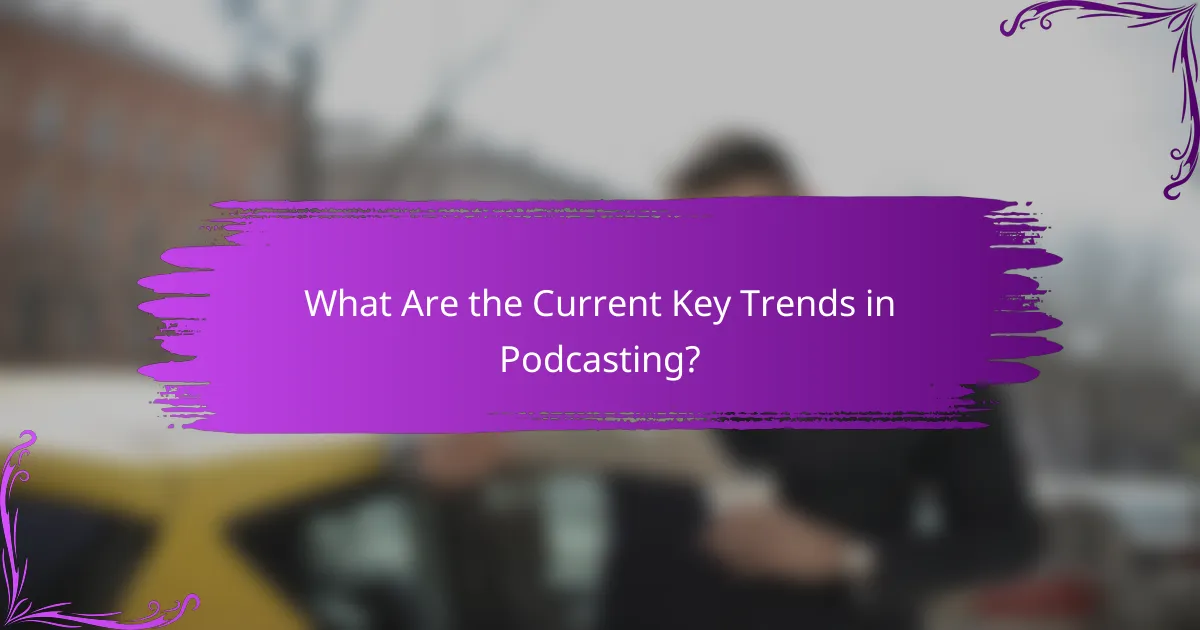
What Are the Current Key Trends in Podcasting?
Key trends in podcasting include increased audience engagement, diversification of content, and monetization strategies. Audience engagement has risen due to interactive formats and listener feedback integration. Content diversification is evident through niche topics and varied genres, attracting broader demographics. Monetization strategies have evolved, with more creators utilizing sponsorships, subscriptions, and crowdfunding. According to Statista, the podcasting market is projected to reach $1 billion in revenue by 2024. This growth indicates a strong demand for diverse and engaging podcast content.
How is the rise of mobile consumption shaping podcasting?
The rise of mobile consumption is significantly shaping podcasting. Mobile devices allow users to access podcasts anytime and anywhere. This convenience increases the overall audience for podcasts. According to Edison Research, 55% of Americans have listened to a podcast, with mobile devices being a primary platform. This shift has encouraged creators to produce shorter, more engaging content suitable for on-the-go listening. Additionally, mobile apps enhance user experience with features like offline listening and personalized recommendations. The growth of mobile consumption has also led to increased advertising opportunities within podcasts, as brands target listeners who are often multitasking.
What role do smart speakers play in podcast accessibility?
Smart speakers significantly enhance podcast accessibility. They allow users to listen to podcasts hands-free through voice commands. This feature benefits individuals with disabilities or those multitasking. Smart speakers support various podcast platforms, making a wide range of content easily available. According to a 2021 report by Edison Research, 41% of smart speaker owners listen to podcasts regularly. This statistic highlights the growing integration of podcasts into daily routines facilitated by smart speakers. Their ability to stream content instantly removes barriers to access, promoting inclusivity in podcast consumption.
How has the COVID-19 pandemic impacted podcast listening habits?
The COVID-19 pandemic has significantly increased podcast listening habits. Many people turned to podcasts for entertainment and information during lockdowns. According to a report by Edison Research, podcast consumption rose by 42% in 2020. Commuting patterns changed as remote work became prevalent, leading to more at-home listening. Additionally, new listeners entered the podcast space, with 41% of Americans aged 12 and older listening to podcasts weekly by early 2021. This shift indicates a broader acceptance of podcasting as a mainstream medium for content consumption.
What innovative formats are emerging in the podcasting landscape?
Innovative formats emerging in the podcasting landscape include narrative-driven series, interactive podcasts, and audio documentaries. Narrative-driven series often feature storytelling elements that engage listeners emotionally. Interactive podcasts allow audience participation through real-time feedback or decision-making. Audio documentaries combine investigative journalism with immersive soundscapes. These formats enhance listener engagement and differentiate content in a crowded market. According to a 2023 report by Edison Research, 40% of podcast consumers prefer narrative-driven content. This statistic highlights the growing demand for innovative formats in the podcasting industry.
How are narrative-driven podcasts changing storytelling approaches?
Narrative-driven podcasts are transforming storytelling approaches by emphasizing immersive audio experiences. They utilize sound design, voice acting, and narrative structure to engage listeners deeply. This format allows for complex storytelling, often blending fiction with real-life events. For example, shows like “Serial” have redefined true crime narratives, creating serialized storytelling that captivates audiences. According to a 2021 report by Edison Research, 75% of podcast listeners prefer narrative-driven content, showcasing its popularity. Furthermore, narrative-driven podcasts encourage serialized content, promoting listener loyalty and anticipation for new episodes. This shift is reshaping how stories are told, focusing on character development and emotional resonance.
What are the benefits of live podcasting events?
Live podcasting events enhance audience engagement and foster community interaction. They allow listeners to participate in real-time discussions. This interaction can lead to increased loyalty among the audience. Live events also create a sense of urgency and exclusivity. Attendees often feel more connected to the hosts and content. According to a study by Edison Research, live events can boost listener retention by 30%. Additionally, live events can generate immediate feedback. This feedback helps hosts tailor future content more effectively. Overall, live podcasting events strengthen the relationship between creators and their audience.

What Strategies Can Enhance Audience Engagement in Podcasting?
To enhance audience engagement in podcasting, creators should implement interactive elements. This includes encouraging listener feedback through social media or dedicated platforms. Engaging with the audience fosters a sense of community. Additionally, incorporating listener questions into episodes can make content more relatable. Using storytelling techniques enhances emotional connection. Consistent release schedules keep audiences anticipating new content. Collaborating with guests can introduce fresh perspectives and attract new listeners. Finally, utilizing analytics helps understand audience preferences, allowing for tailored content. These strategies collectively improve listener retention and satisfaction.
How can podcasters effectively build their audience?
Podcasters can effectively build their audience by consistently producing high-quality content. Engaging storytelling and relevant topics attract listeners. Utilizing social media platforms increases visibility and encourages sharing. Collaborating with other podcasters can expose them to new audiences. Email newsletters can keep listeners updated and foster loyalty. SEO optimization for podcast titles and descriptions enhances discoverability. Encouraging listener feedback creates a sense of community. According to a 2022 Edison Research report, 80% of podcast listeners prefer shows that engage with their audience.
What role do social media platforms play in audience engagement?
Social media platforms play a crucial role in audience engagement by facilitating direct interaction between content creators and their audience. They enable real-time communication, allowing creators to receive immediate feedback. This interaction fosters a sense of community among listeners. Social media also helps in promoting podcast episodes, increasing visibility and reach. According to a 2021 report by Edison Research, 55% of podcast listeners engage with podcasts through social media. This statistic highlights the importance of these platforms in driving audience participation and loyalty.
How important is community interaction for podcast growth?
Community interaction is crucial for podcast growth. Engaging with listeners fosters loyalty and encourages word-of-mouth promotion. Research indicates that podcasts with active community engagement see a 30% increase in listener retention. Interaction can occur through social media, listener feedback, and live events. These channels create a sense of belonging among listeners. A strong community can also provide valuable content ideas and feedback for future episodes. Furthermore, podcasts that prioritize community often experience higher rates of audience growth. This interaction builds trust and enhances the overall listening experience.
What techniques can improve listener retention rates?
Engaging storytelling techniques can significantly improve listener retention rates. Incorporating personal anecdotes creates a connection with the audience. Using cliffhangers at the end of episodes encourages listeners to return for more. Consistent episode formatting helps set listener expectations. High-quality audio production enhances the overall experience. Regularly soliciting listener feedback fosters community involvement. Implementing listener-driven content can increase relevance and interest. Research shows that podcasts with interactive elements see higher engagement levels.
How can consistent content scheduling affect audience loyalty?
Consistent content scheduling can significantly enhance audience loyalty. Regularly scheduled content builds anticipation among listeners. It establishes a reliable routine, making it easier for the audience to engage. This predictability fosters a sense of trust and connection. According to a study by the Content Marketing Institute, 70% of consumers prefer brands that provide consistent content. Additionally, podcasts released on a consistent schedule see higher retention rates. This consistency encourages listeners to return, reinforcing loyalty over time.
What are effective ways to solicit listener feedback?
Effective ways to solicit listener feedback include using surveys, social media engagement, and direct email communication. Surveys can be distributed through platforms like Google Forms or SurveyMonkey. They allow for structured feedback collection. Social media can facilitate real-time interaction and comments from listeners. Engaging with listeners on platforms like Twitter or Instagram encourages open dialogue. Direct email communication can also be effective. It allows listeners to share detailed thoughts and suggestions. According to a 2021 study by Edison Research, 70% of podcast listeners prefer giving feedback through social media. This indicates the importance of utilizing these channels for effective feedback solicitation.
What are best practices for creating a successful podcast?
Successful podcast creation involves planning, content quality, and audience engagement. Start by defining your target audience and niche. Research their interests to tailor your content effectively. Consistent publishing schedules enhance listener loyalty. Invest in quality audio equipment to ensure clear sound. Engaging storytelling captivates listeners and encourages sharing. Promote your podcast on social media and podcast directories for visibility. Collaborating with other podcasters can expand your reach. Finally, analyze listener feedback and metrics to refine your approach.
How can podcasters choose the right niche for their content?
Podcasters can choose the right niche by identifying their interests and expertise. They should consider topics they are passionate about. Analyzing existing podcasts can reveal gaps in the market. Researching audience demographics helps target specific listener groups. Engaging with potential listeners through surveys can provide valuable insights. Evaluating trends in podcasting can guide niche selection. Successful podcasters often focus on underserved audiences. This approach can lead to higher engagement and loyalty.
What technical aspects should be prioritized in podcast production?
Audio quality is the most critical technical aspect in podcast production. High-quality audio ensures listener engagement and retention. This includes using professional microphones to capture clear sound. Proper acoustics in the recording environment reduce background noise. Additionally, sound editing software enhances audio clarity and removes unwanted sounds. Consistent volume levels across episodes maintain a professional standard. Lastly, reliable hosting platforms ensure stable distribution and accessibility for listeners. These factors collectively contribute to a successful podcast production.
The main entity of the article is podcasting, a digital audio medium that has evolved significantly since its inception in the early 2000s. The article explores the history of podcasting, key milestones, and the impact of technological advancements, such as RSS feeds and mobile consumption, on its growth. It also examines current trends, audience engagement strategies, and the demographic shifts driving listener growth. Additionally, the piece highlights innovative formats, techniques for enhancing audience retention, and best practices for creating successful podcasts, providing a comprehensive overview of the podcasting landscape as of 2023.
